Beneficial
none known
Family: Scarabaeidae Subfamily: Scarabaeinae Genus: Phanaeus Species: Phanaeus daphnis Harold, 1863
none available
Total body length 13.0–19.0 mm (0.51–0.74 in). Color metallic green, rarely blue or yellow-green. Head of major male with single large horn; horn reduced in minor males, lacking in female. Clypeusclypeus:
part of the head anterior to the frons; the most anterior portion in dorsal view
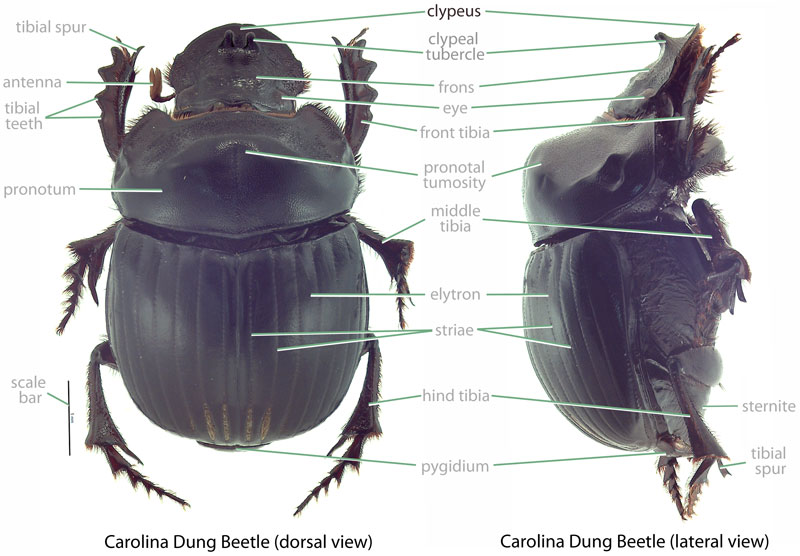 usually rounded, sometimes triangular or trapezoidal; never strongly emarginated. Pronotumpronotum:
usually rounded, sometimes triangular or trapezoidal; never strongly emarginated. Pronotumpronotum:
the dorsal surface of the thorax
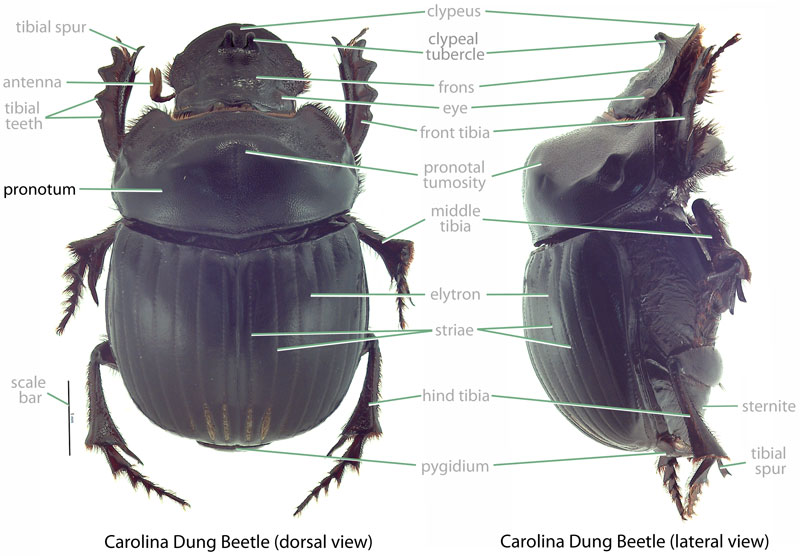 of major male with 3 elevated ridges; ridges reduced in minor males, absent in females. Pronotal surface at lateral margins granulategranulate:
of major male with 3 elevated ridges; ridges reduced in minor males, absent in females. Pronotal surface at lateral margins granulategranulate:
relating to a coarse, grainy surface texture
. ElytraElytra:
the hardened and chitinous wing-cover of a beetle that protect and overlie the flight wing
with distinct striaestriae:
a longitudinal depressed line or furrow, often formed from numerous punctures that extends the length of an elytron
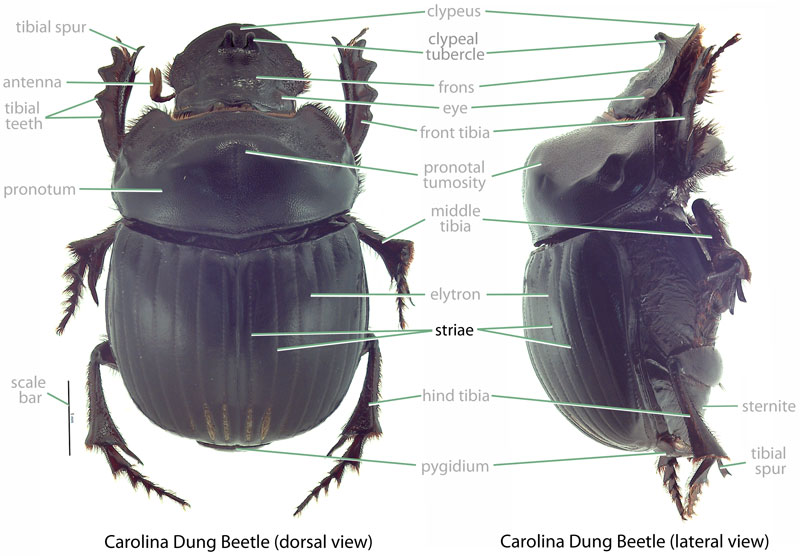 . Middle and hind legs without claws.
. Middle and hind legs without claws.
Undescribed. For Phanaeus species (Ritcher, 1966Ritcher, 1966:
Ritcher P. 1966. White grubs and their allies: a study of North American scarabaeoid larvae. Oregon State University Monographs, Studies in Entomology 4: 1-219.): Maxillamaxilla:
set of paired mouthparts located posterior to the mandibles
with galeagalea:
outer branch or lobe of the maxilla
 and lacinialacinia:
and lacinialacinia:
inner portion of the maxilla distinctly separated. Epipharynxepipharynx:
distinctly separated. Epipharynxepipharynx:
lobe on the interior surface of the labrum or clypeus
with tormaetormae:
in scarab larvae, sclerotized structures on the ends of the clypeolateral suture extending towards the mesal line
united mesallymesally:
at or near midline of body
, anterioranterior:
the front or forward; opposite of posterior
phoba present. Antennaantenna:
paired sensory organ on head, formed from numerous segments
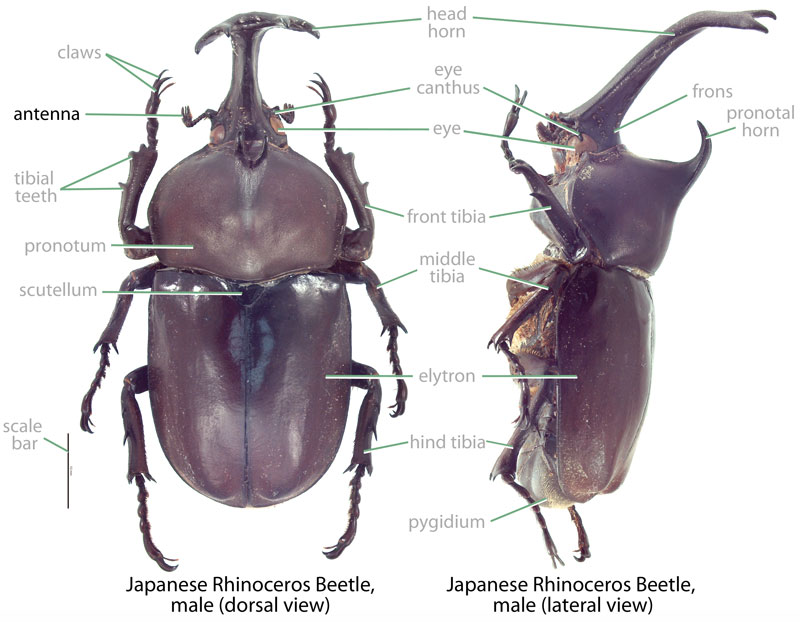 4- segmented; distaldistal:
4- segmented; distaldistal:
situated away from the point of articulation, thus usually furthest from the body
segment of antennaantenna:
paired sensory organ on head, formed from numerous segments
 much reduced in size. Prothoracic shieldprothoracic shield:
much reduced in size. Prothoracic shieldprothoracic shield:
the chitinous plate behind the head of larvae
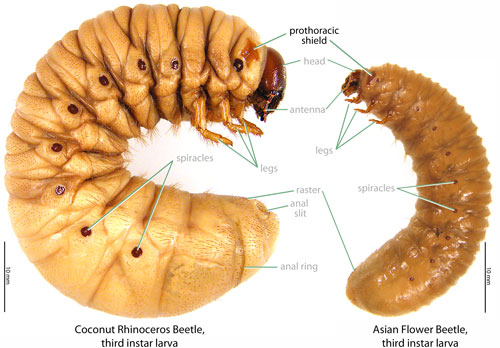 with an anteriorly projecting, angular process on each side. Legs 2-segmented; lacking claws, instead with a single terminal setaseta:
with an anteriorly projecting, angular process on each side. Legs 2-segmented; lacking claws, instead with a single terminal setaseta:
small, hair-like structure
. Last abdominal segment with median portion of venter covered with a large quadratequadrate:
square-like in shape
patch of stout, caudally directed, spine-like setae; venter with a single, broad, caudalcaudal:
oriented towards the posterior
, median lobe.
Mexico. This species is known from the transvolcanic belt of central Mexico where it occurs at elevations between 1,000 and 1,600 meters (Edmunds, 1994).
None. This species feeds on dung as both an adult and larvalarva:
the immature form of an insect; in scarabs, also called grub or white grub; preceded by the egg stage, followed by the pupal stage
 (Price and May, 2009Price and May, 2009:
(Price and May, 2009Price and May, 2009:
Price D and May M. 2009. Behavioral ecology of Phanaeus dung beetles (Coleoptera: Scarabaeidae): review and new observations. Acta Zoológica Mexicana 25: 211-238. full text (accessed 2015)). There are no records of this scarab feeding on live plant tissues.
(Price and May, 2009Price and May, 2009:
Price D and May M. 2009. Behavioral ecology of Phanaeus dung beetles (Coleoptera: Scarabaeidae): review and new observations. Acta Zoológica Mexicana 25: 211-238. full text (accessed 2015)): Like the majority of Phanaeus species, P. daphnis feeds on mammalian dung. The droppings of omnivores such as swine and humans are preferred, but the dung of herbivores such as cattle is readily accepted. Carnivore dung is the least preferred. Females locate dung by flying low over the ground, then land near (but rarely on) the feces. Using their front legs, females move a portion of the dung up to 18 m (59 ft) from the original site. Unlike most other Phanaeus species, the P. daphnis beetle does not aid in moving the dung. Dung is deposited in a burrow and formed into a pear-shaped brood ball. The brood ball is impregnated with an egg and then enclosed in clay (perhaps to prevent dessication). No further parental care takes place, though adults may continue to inhabit the burrow. In the native range, breeding takes place between June and November. Adult females lay approximately 12 eggs over 180 days. Adults are diurnaldiurnal:
active during daylight hours
.
None. This species recycles dung and is beneficial for ranching and farming in Hawaii. As an obligate dung feeder, this species poses no threat to crop or ornamental plants. Additionally, this species is not a threat to native dung beetles because none occur in Hawaii or Guam.
Recorded, not established. This species was intentionally released in Hawaii with the goal of controlling populations of the horn fly (Haematobia irritans). Introductions were made in 1954 at Parker Ranch on Big Island (Weber, 1954Weber, 1954:
Weber P. 1954. Recent liberations of beneficial insects in Hawaii–IV. Proceedings of the Hawaiian Entomological Society 15: 635-638. full text (accessed 2015)). In 1955, further introduction attempts were made at Molokai Ranch on Molokai and Waimea on Kauai (Weber, 1955Weber, 1955:
Weber P. 1955. Recent introductions for biological control in Hawaii—1. Proceedings of the Hawaiian Entomological Society 16: 162-164. full text (accessed 2015)). Despite these release attempts, the beetle apparently never established self-sustaining populations (Nishida, 2002Nishida, 2002:
Nishida G (editor). 2002. Hawaiian terrestrial arthropod checklist, fourth edition. Bishop Museum Technical Report 22: 1-313.).
Not established or recorded. There are no records of this species from Guam.
In Hawaii, this species was intentionally released but did not establish.
With their distinctive shape and coloration, major males of the Phanaeus daphnis are unmistakable. However females and minor males could be confused with the green form of Canthon pilularius. P. daphnis can be separated from C. pilularius by examination of the rear tarsitarsi:
the distal part of an insect leg attached to the tibia and consisting of five sub-segments in scarab beetles; bears the tarsal claws
(P. daphnis lacking rear tarsal claws versus C. pilularius with rear tarsal claws) and the apexapex:
point or edge furthest from the body
of clypeusclypeus:
part of the head anterior to the frons; the most anterior portion in dorsal view
 (P. daphnis clypeal clypeal:
(P. daphnis clypeal clypeal:
of, or referring to, the clypeus
apexapex:
point or edge furthest from the body
rounded versus C. pilularius with clypeusclypeus:
part of the head anterior to the frons; the most anterior portion in dorsal view
 distinctly emarginated).
distinctly emarginated).
Phanaeus coerulus Bates, Phanaeus herbeus Bates, Phanaeus substriolatus Balthasar, Phanaeus tricornis Olsoufieff
Report your observation of this beneficial species at our iNaturalist project.